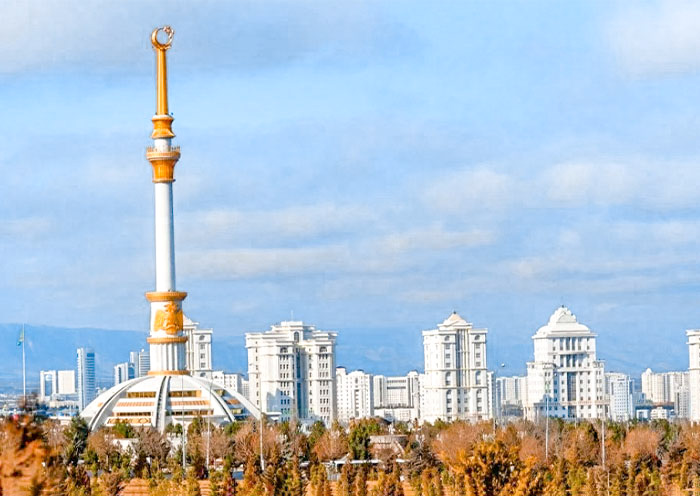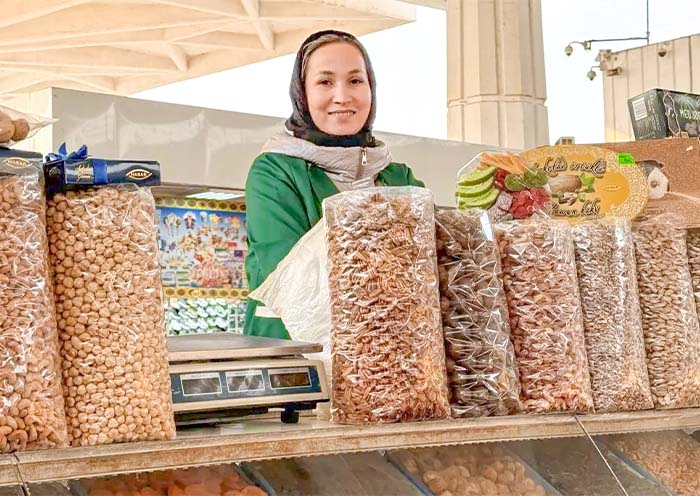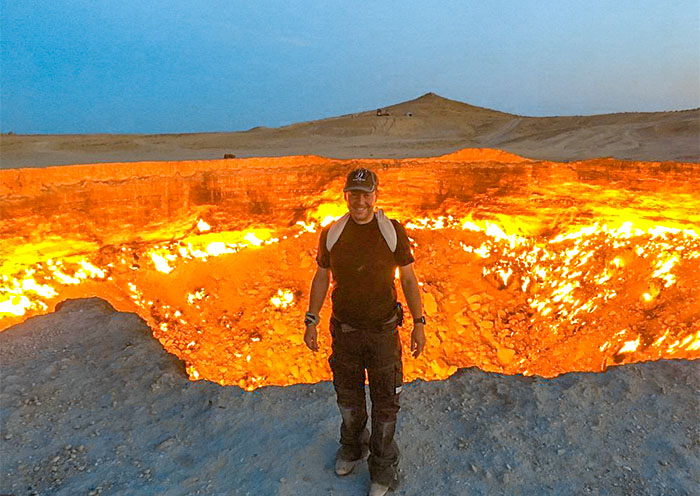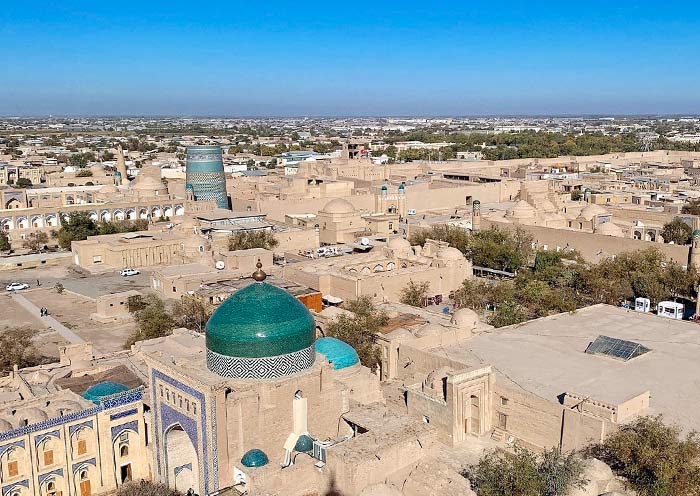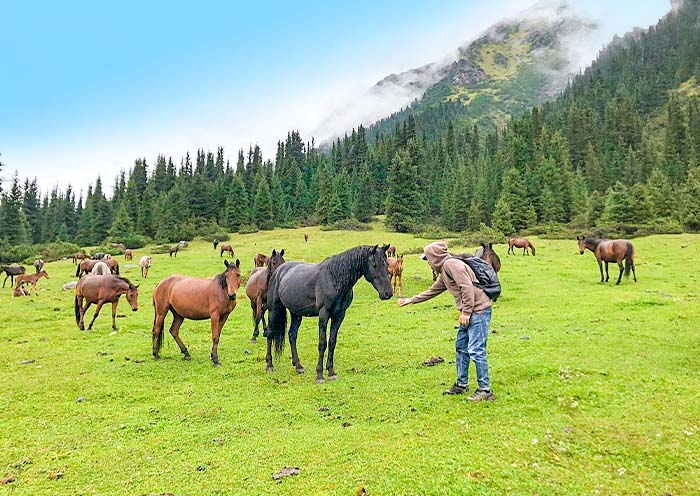5 Days Classic Turkmenistan Tour: UNESCO Ancient Wonders & Door to Hell
- Highlights
- Itinerary
- Price
- Trip Notes
- Accommodation
- Photos
- Reviews
Explore All Best Highlights of Turkmenistan: Ancient Ruins, Door to Hell, Ashgabat
Turkmenistan is blanketed by the Karakum Desert, which covers more than 80% of the country. Yet, what truly attracts travelers is not the desert landscape, but the ancient cities, splendid history, powerful empires, and the world-famous “Door to Hell.”
Join our 5-day classic Turkmenistan tour with compact and efficient itinerary. Your journey begins in the capital, Ashgabat, the dazzling “White Marble City” recognized in the Guinness World Records. Surreal and magnificent, it is a flourishing modern metropolis rising from the desert.
The tour also takes you to two UNESCO World Heritage Sites - the ancient city of Merv, once a capital of the Seljuk Empire, and Kunya-Urgench, the former capital of the Khwarazmian Empire. Another highlight is the legendary Darvaza Gas Crater (the “Door to Hell”), arranged at the best time in the evening and night to witness its most spectacular view, followed by memorable desert camping experience.
From UNESCO treasures to the blazing Door to Hell, this tour blends Turkmenistan’s ancient glory with its modern wonders. Travel with Asia Odyssey Travel - the Central Asia experts in cultural discovery and adventure.
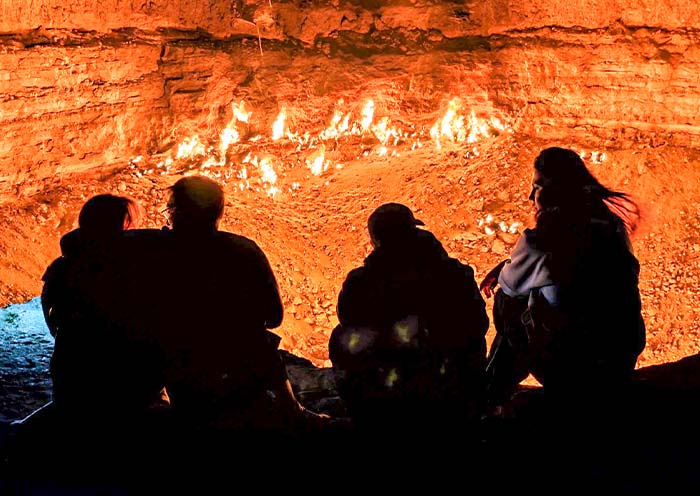
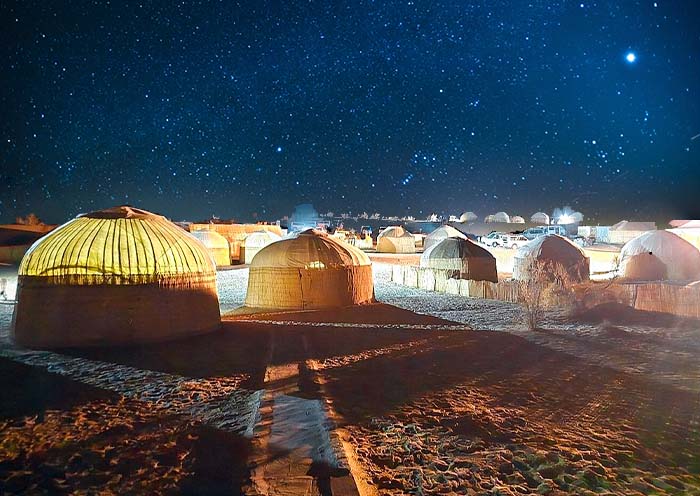

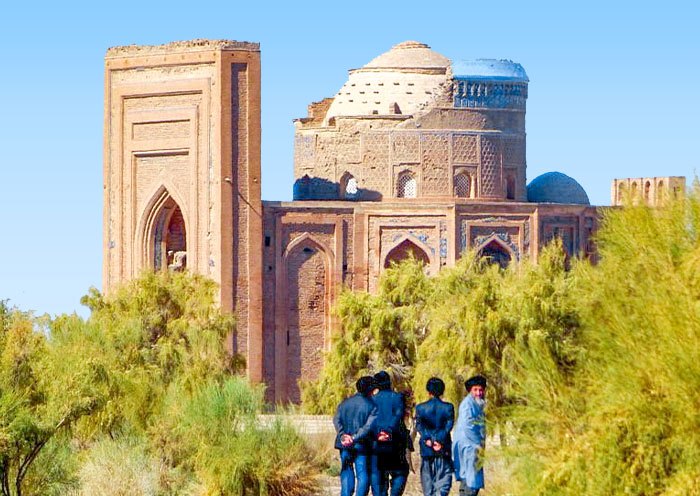

Itinerary at a Glance
Ashgabat (Turkmenistan) (1 Day)
Arrive in Ashgabat
Ancient Merv, Mary (1 Day)
Ashgabat flight to Mary; Ancient Merv, Mary History Museum
Ashgabat (0.5 Day)
Neutrality Monument, National Museum of Turkmenistan, Independence Monument, Ertugrul Gazi Mosque
Darvaza Gas Crater (1 Day)
Darvaza Burning Gas Crater, night camp in the dersert
Kunya-Urgench (0.5 Day)
Kutlug-Timur Minaret, Mausoleum of Sultan Tekesh, Mausoleum of Turabeg Khanum, Mausoleum of Il Arslan, Daşoguz Airport back to Ashgabat
Ashgabat (1 Day)
Itinerary Day by Day
Hello friend, welcome to Turkmenistan! This fascinating country borders Kazakhstan and Uzbekistan to the north and northeast. Among the five “Stans,” Turkmenistan offers you white-marble capital, the famous Door to Hell, and Silk Road relics. Get ready for a journey filled with mystery, surreal cityscapes, and glorious past.
Upon arrival at Ashgabat International Airport (ASB), your local guide and driver will be waiting to transfer you to your downtown hotel. (Tip: the airport is about 10 km northwest of Ashgabat, around 20-minute drive.)
Arrival Ideas to Ashgabat (Flights Available):
Many international flights connect to Turkmenistan, though not on a daily basis. You can fly nonstop to Ashgabat from cities such as Moscow (4h), Istanbul (4h 15m), London (7h 10m), Milan (6h 20m), Frankfurt (7h 5m), Dubai (2h 30m), Bangkok (6h 45m), Beijing (6h), Urumqi (3h 25m), Seoul (7h 40m), Ho Chi Minh City (8h 20m), Delhi (3h 40m), and Kuala Lumpur (8h 10m), and more. Tell us your departure city, and we’ll help you find the best flight options.
Ashgabat, the capital, is a pure white world, truly unique. It has been recognized by the Guinness World Records as the city with the highest density of white marble buildings. More than 500 structures are decorated with shining marble. Your driver will take you on a ride through these white giants, making you feel as if you’ve entered film-like world, similar to The Truman Show. Along the way, you’ll pass the Wedding Palace, designed in the shape of an octagonal star and certified as the world’s largest star-shaped building. Upon arrival, check in to your hotel and enjoy a good rest today.
Travel Tips: If you arrive early today, you'll have a chance to explore the Horse Stables to see the national pride of the Turkmen people, the Akhal-Teke horses, revered as some of the most beautiful horses in the world. Known as "heavenly horses," their most prominent feature is their metallic sheen.
You can also visit Gulistan Bazaar to experience vivid local life as you explore stalls filled with fresh fruits, vegetables, spices, and daily necessities or even Turkmen carpet. Feel free to try some local food here if you like.
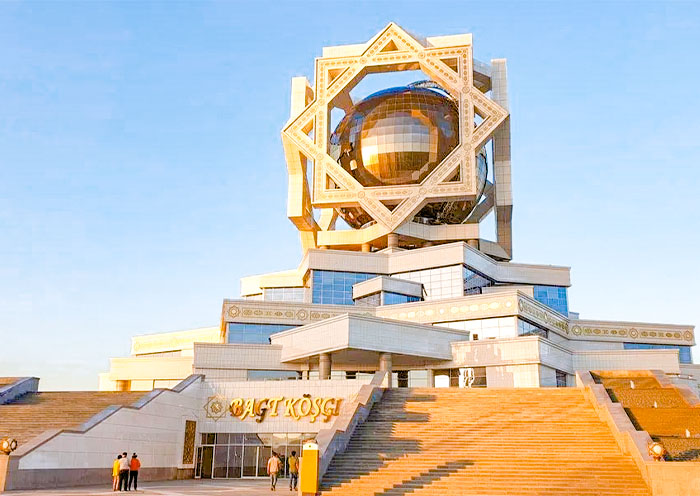
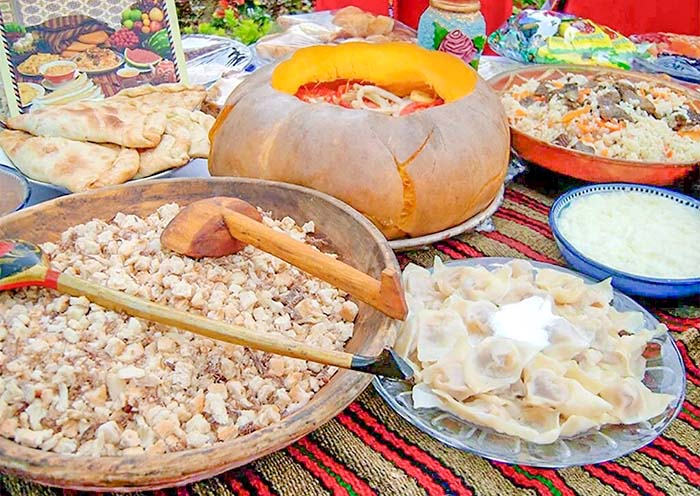
After breakfast, you will be escorted to the Ashgabat airport for your flight to Mary (312km, 40 minutes).
Upon arrival at Mary International Airport, our driver will pick you up and transfer you to Ancient Merv, located 33km northeast of Mary. This UNESCO World Heritage site is the oldest and best-preserved of the oasis-cities along the Silk Route in Central Asia. It has spanned over 4,000 years’ history. During the medieval period, its population exceeded one million, making it one of the largest cities in the world. It was known as the "Queen of the World" and the "Jewel of the Silk Road."
Within the vast 1,200-hectare archaeological park, you'll have the chance to observe all the constituent parts of this "wandering city." The site consists of a series of adjacent cities, roughly divided into the ancient (Erk Kala and Gyaur Kala), the medieval (Sultan Kala), and the post-medieval (Abdulla-Khan Kala and Bayram-Ali-Khan Kala). Besides these remnants, you'll also visit the 6th-9th century AD forts of Big and Little Kyz-Kalas, which are excellent examples of the so-called "corrugated Koshks." You'll also explore the splendid 12th-century mausoleums of Sultan Sanjar and Muhammed ibn-Zeyd, which demonstrate exquisite Seljuk-period brickwork and architectural décor.
After sightseeing, we'll head back to Mary to visit the local Regional Museum. The museum presents a wide array of archaeological finds dating back from the 3rd millennium BC to the late 19th century. The collections come from both Ancient Merv and Bronze Age sites of the Margush region, as well as interesting ethnographic displays that reconstruct the daily lives of the local Turkmen population.
In the evening, take a return flight to Ashgabat (40 mins). Our driver will meet you at the airport and transfer you to your hotel in Ashgabat.
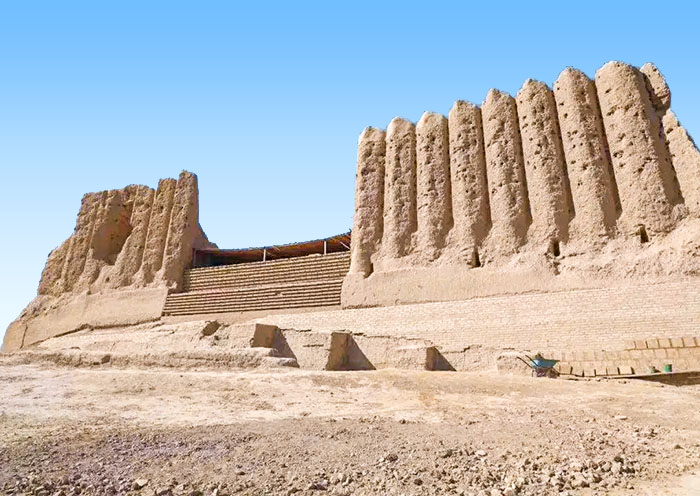
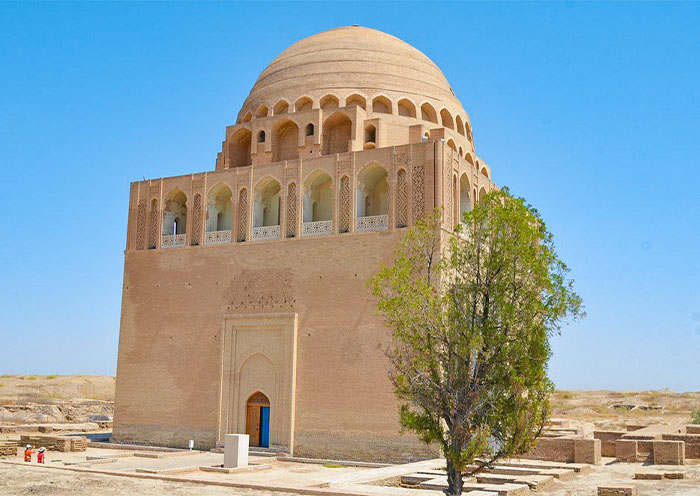
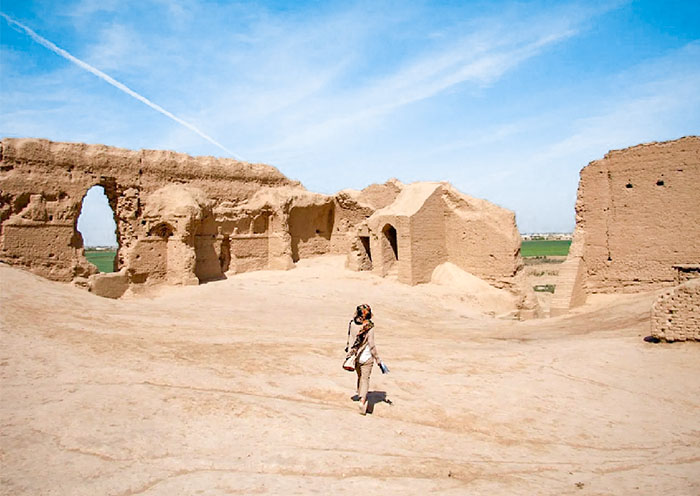
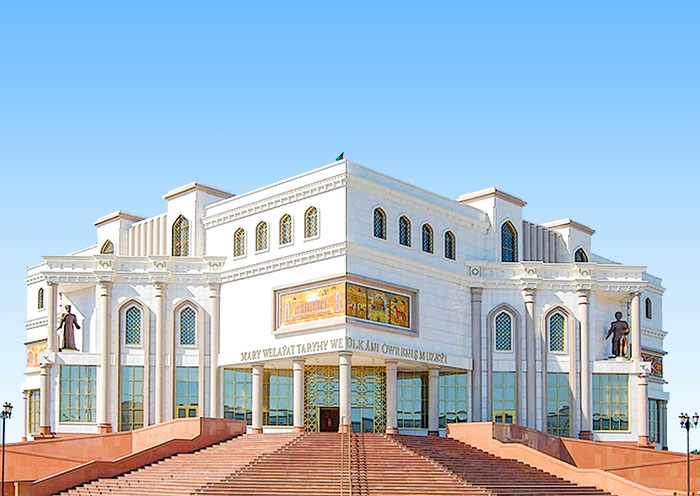
After breakfast, it is time to explore the stunning city highlights and striking architectures of Ashgabat. Start your day at the Neutrality Monument. Built in 1998, this 75-meter-high, tripod-shaped arch symbolizes Turkmenistan's permanent neutrality, power, and commitment to peace and goodwill.
Next, you'll move to the National Museum of Turkmenistan. This magnificent museum is one of the largest in Central Asia. Its striking exterior is a huge white marble building with unique blue dome, golden statues, and grand colonnades. Magnificent and beautiful! With a collection of over 500,000 items, there's plenty to explore. You can view archaeological finds from important Silk Road sites like Nisa, Merv, and Gonur Depe. See ancient artifacts such as coins, weapons, fine pottery, and gold jewelry. Be sure to see the museum's prized treasure: the ancient rhytons. You'll also see traditional clothing and other exhibits that capture the national spirit.
Later, you'll see the Independence Monument within Independence Park. This beautiful park is home to many statues of Turkmen poets, thinkers, and national heroes. You can also marvel at the 118-meter monument, which was built to commemorate Turkmenistan's independence from the Soviet Union in 1991.
After that, continue to the Ertugrul Gazi Mosque. Built in the 1990s as a gift from the Turkish government, this magnificent mosque was constructed entirely in the style of the Ottoman Empire, and its exterior is very similar to Istanbul's famous Blue Mosque. Upon arrival, you'll be struck by its four towering minarets and a magnificent central dome, all built from solemn white marble. Once inside, you'll be amazed by the opulent decoration, including delicate gilded carvings, intricate mosaic tiles, and huge crystal chandeliers, creating sacred and serene atmosphere.
After the city tour, it's time to be transferred to the Darvaza Burning Gas Crater, a journey of 272km (4-5 hours). We'll travel through the Karakum Desert, with its moving sands and sparse vegetation. After turning off the main road, we'll begin an exciting eight-kilometer desert drive, which will bring us within a few hundred meters of the flaming crater. You've now arrived at the "Door to Hell"!
The crater was formed in 1971 when Soviet geologists were drilling for natural gas. The ground beneath their rig collapsed, leaving a large hole with a diameter of 60 meters and a depth of 20 meters. To prevent the release of poisonous gas, they decided to light it on fire, hoping it would burn itself out in a few days. The gas, however, is still burning today.
At daylight, the crater may seem like an ordinary hole in the ground, with a slight haze of smoke. We'll take a walk around the site while our barbecue dinner is being prepared. As dusk falls, the simple hole transforms into a spectacular "fire temple," creating an otherworldly atmosphere that will ignite your imagination. We'll finish the day with a taste of delicious nomadic food, with the flickering lights of the "eternal" fire.
Stay overnight in a traditional yurt camp. (Note: The camp provides basic, shared outdoor washing and toilet facilities.)
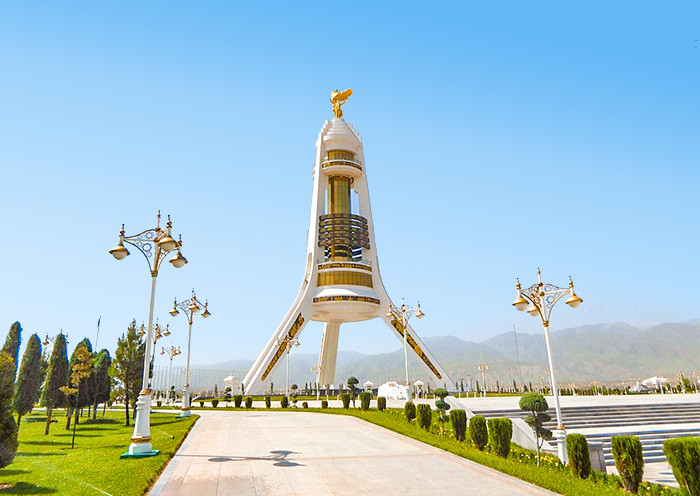

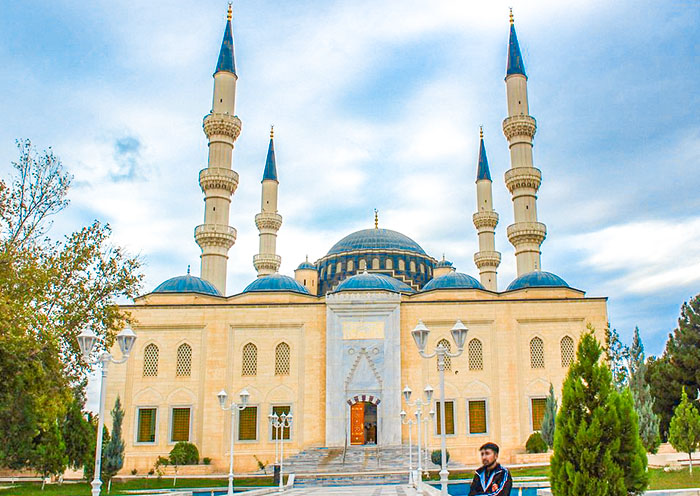
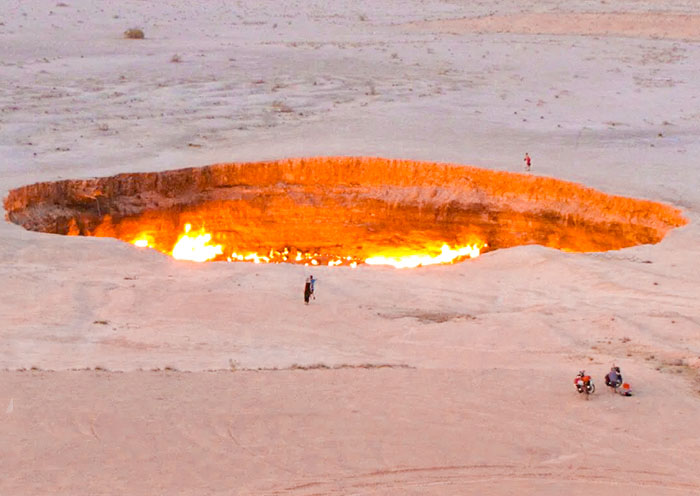
This morning, enjoy picnic-style breakfast at Darvaza in the desert. Afterward, drive north through the vast Karakum Desert to Kunya-Urgench (276 km, about 5 hours).
Located in northwestern Turkmenistan, Kunya-Urgench was once one of Central Asia’s most prosperous cities and the capital of the powerful Khwarazmian Empire. It reached its peak in the 11th–12th centuries as both a major Silk Road trade hub and a leading center of science, culture, and art in the Islamic world. Many renowned scholars worked here, making it a city to rival Bukhara and Samarkand. Today, what you see are ancient ruins (dating from the 11th to 16th centuries) scattered across the desert landscape, but the site is in fact recognized as an important UNESCO World Heritage Site (since 2005). It is a place where you can trace the diverse methods and decorative styles of Islamic architecture in Central Asia.
On arrival, begin your visit at the Kutlug-Timur Minaret, soaring 60 meters high and the tallest structure on site. Continue to the Mausoleum of Sultan Tekesh (12th century), noted for its distinctive conical dome. Then explore the highlight of the complex, the Mausoleum of Turabeg Khanum (14th century), one of the most magnificent in the city. Take time to step inside and admire its breathtaking dome and intricate decorations. Also visit the Mausoleum of Il Arslan (12th century), where the square base and decorative brickwork reflect early Islamic architecture.
Afterward, enjoy some free time to wander the site at your own pace. Later, transfer to Daşoguz Airport for your evening flight to Ashgabat (about 50 minutes).
Travel Tip: Daşoguz Airport is southeast of Kunya-Urgench, about 107 km away, requiring 1.5–2 hour drive.
Upon arrival in Ashgabat, transfer to your hotel for overnight.

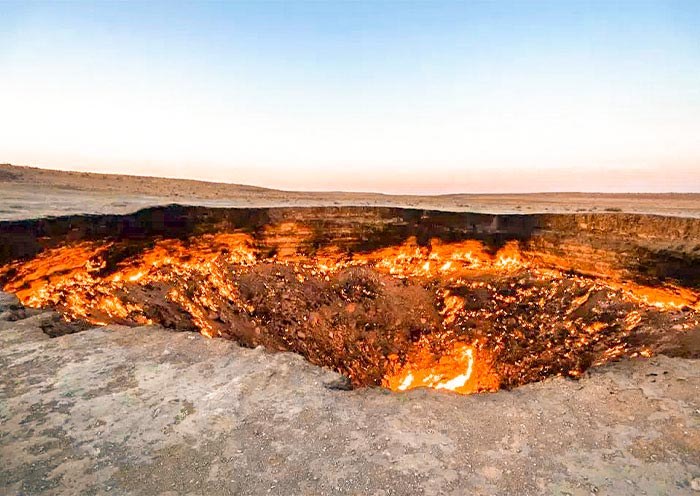
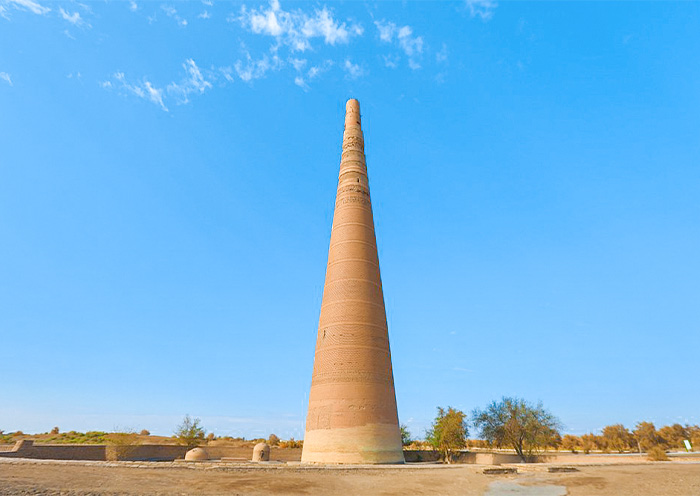
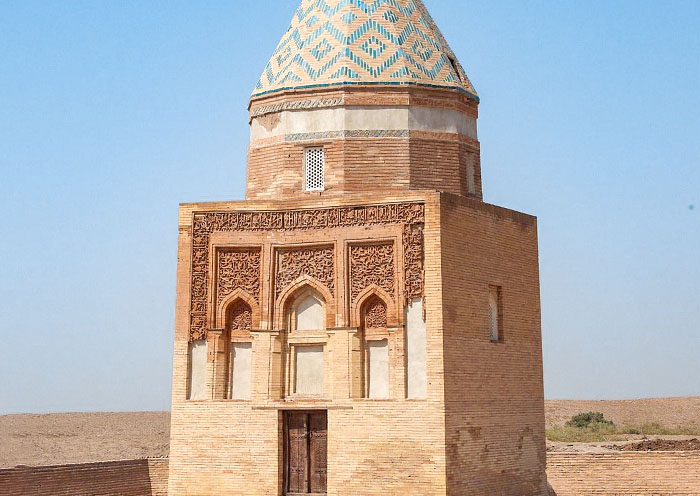
After breakfast, you will have some free time to explore Ashgabat. Afterward, you will be transferred to the airport for your flight to your next destination or to return home. Your 5-day Turkmenistan tour concludes here. (Tip: Please inform us of your flight details so we can arrange your airport transfer accordingly.)
Optional Extension:
Turkmenistan is part of a larger Central Asia tour. You can also cover other highlights in Kazakhstan, Uzbekistan, Kyrgyzstan, and Tajikistan. We can tailor Central Asia tour based on your preferred duration and interests.
Thank you for choosing Asia Odyssey Travel for your Turkmenistan tour. We look forward to welcoming you back for your next adventure!
Price: What’s Included & What’s Excluded
What's Included:
What's Excluded:
Central Asia Trip Notes & Booking Tips
| Country | Highlights | Must-Do Experiences |
|---|---|---|
| Kazakhstan | Endless steppe, futuristic cities, striking natural wonders | Explore Almaty’s lively streets, marvel at Charyn Canyon, ride cable cars to mountain viewpoints, and learn about nomadic horse culture |
| Kyrgyzstan | Mountain peaks, alpine lakes, nomadic spirit | Stay in a yurt at Issyk-Kul Lake, visit Burana Tower, hike alpine gorges, and watch eagle hunting demonstrations |
| Uzbekistan | Silk Road jewels, turquoise domes, vibrant bazaars | Wander Registan Square in Samarkand, explore Bukhara’s old town, admire mosaics in Shakhrisabz, shop for silk, spices, and carpets |
| Tajikistan | Rugged mountains, hidden valleys, Sogdian history | Discover Penjikent’s ruins, trek to the Seven Lakes, and meet locals in remote mountain villages |
| Turkmenistan | Marble cities, desert mysteries, Silk Road ruins | Camp by the fiery Darvaza Gas Crater, explore Ancient Merv, and see Ashgabat’s white-marble monuments |
- Spring (April June): Mild weather, blooming valleys, fewer crowds
(1) Perfect for sightseeing in Uzbekistan’s Silk Road cities (Samarkand, Bukhara, Khiva) before the summer heat. (2) Kyrgyzstan’s and Kazakhstan’s mountains are lush and green, great for gentle hikes. (3) Desert areas in Turkmenistan are comfortable for visiting Darvaza Gas Crater and Merv.
- Autumn (September October) - Most Recommended Season: Pleasant temperatures, colorful landscapes
(1) Ideal time for a grand tour of all 5 Stans. (2) Crisp, sunny days make exploring cities and mountain regions easy. (3) Harvest season - fresh fruits, bazaars full of melons, grapes, pomegranates. (4) Issyk-Kul Lake and alpine gorges in Kyrgyzstan are at their most photogenic.
- Summer (July August): Hot in deserts & Silk Road cities (up to 40°C), but: great for high-altitude trekking in Kyrgyzstan and Tajikistan (Pamir Mountains, Seven Lakes).
For most western / developed-country travelers, Kazakhstan, Kyrgyzstan, Uzbekistan, and Tajikistan are fairly easy to enter (visa-free or e-visa) if you plan properly.
Turkmenistan remains the most challenging: must plan ahead, may need a LOI, possibly limit to tour operator itineraries.
Always check entry point regulations (airport vs land border), as some visas / e-visas / visa-on-arrival are only valid through certain border crossings.
Double-check the duration you're allowed (30, 45, 60, 90 days) - depends heavily on your passport country.
| Theme | Highlights | Where |
|---|---|---|
| Silk Road Cultures | Wander historic Silk Road cities with turquoise domes and caravanserais | Uzbekistan: Samarkand, Bukhara, Khiva |
| Explore an ancient Sogdian city and its 7thcentury frescoes | Tajikistan: Penjikent | |
| Contrast Ashgabat’s modern whitemarble skyline with the ruins of ancient Merv | Turkmenistan: Ashgabat, Merv | |
| Meet artisans weaving carpets, baking traditional bread, crafting felt yurts - living nomadic traditions | Across Central Asia (community workshops, markets, yurt makers) | |
| Nature Landscapes | Marvel at the Darvaza Gas Crater glowing in the Karakum Desert | Turkmenistan: Darvaza, Karakum Desert |
| Relax by IssykKul, the “Pearl of Kyrgyzstan,” ringed by snowcapped peaks | Kyrgyzstan: IssykKul Lake | |
| Hike to Tajikistan’s Seven Lakes or explore the “little brother” to the Grand Canyon | Tajikistan: Seven Lakes; Kazakhstan: Charyn Canyon | |
| Experience nomadic life in a yurt camp, ride horses in alpine valleys, stargaze on the steppe | Kyrgyzstan, Kazakhstan (yurt camps, alpine pastures) |
- Darvaza Gas Crater camping with desert stargazing
- In-depth Silk Road exploration of Samarkand’s old city
- Tajikistan’s Seven Lakes hike with a lakeside picnic
- Kyrgyz falconry show and hands-on yurt-making experience
- Charyn Canyon hike plus Almaty cable car to a skyline night view
- Tajik home visit with demonstrations of traditional handicrafts
Our tour is designed to provide a comprehensive experience without feeling overly rushed. We balance city tours with travel days to ensure you get enough rest. While some days involve long drives between destinations, we plan strategic stops for sightseeing and breaks. You'll have time to explore the major sites in each city and enjoy the journey between them. The pace varies by region: cities like Samarkand are fast-paced, while the mountain regions of Tajikistan and Kyrgyzstan offer a slower, more relaxed tempo.
Here’s what to expect at the most commonly used checkpoints:
| Border Crossing | Connects | Opening Hours | Crossing Time | Crossing Type | Notes for Travelers |
|---|---|---|---|---|---|
| Oybek | Tashkent (Uzbekistan) ⇆ Khujand (Tajikistan) | Daily, usually 08:00–18:00 | ~30–60 min (may be longer on weekends/holidays) | Pedestrian & vehicle | One of the busiest crossings; be ready for lines. Good road conditions on both sides. |
| Jartepa | Samarkand (Uzbekistan) ⇆ Penjikent (Tajikistan) | Daily, 08:00–18:00 | ~20–40 min | Pedestrian & vehicle | Most convenient for travelers; short transfer, border staff generally friendly. |
| Shavat | Khiva/Urgench (Uzbekistan) ⇆ Dashoguz (Turkmenistan) | Daily, 09:00–18:00 | ~45–90 min | Pedestrian only (vehicles drop/pick up travelers at both sides) | Requires Turkmen visa in advance or pre-arranged LOI. Can be busy in mornings. |
| Farap | Bukhara (Uzbekistan) ⇆ Turkmenabat (Turkmenistan/Mary route) | Daily, 08:00–18:00 | ~1–2 hrs | Pedestrian & vehicle | Key crossing for travelers heading to Merv; customs can take longer, be patient. |
| Korday | Bishkek (Kyrgyzstan) ⇆ Almaty (Kazakhstan) | Open 24 hrs | ~30–60 min (rush hours longer) | Pedestrian & vehicle | Major highway crossing, usually efficient; popular with locals and travelers. |
Traveler Tips:
- Timing Matters: Arrive early in the morning to avoid queues, especially at Shavat & Farap.
- Paperwork Ready: Keep passports, visas (or e-visa printouts), and customs forms handy.
- Walking vs. Vehicle:At some borders (Shavat, Oybek), you may need to walk across the neutral zone (few hundred meters).
- Seasonal Considerations: Summer is busier due to local travel; winter may bring delays from weather.
- Patience & Flexibility: Border procedures are generally friendly but not always fast - use this time to experience the real pace of Central Asia.
Hotels & Camping Experiences in Central Asia




We carefully select accommodations across the five “Stans” to ensure both comfort and authenticity.
In Cities:
You will stay in well-located hotels (3-5 stars, with 4 stars recommended) - a mix of international chains and charming boutique hotels. All are clean, comfortable, non-smoking, and offer easy access to lively bazaars, shopping streets, and major attractions. Free Wi-Fi is available in most properties.
In Villages & Countryside:
Around the Seven Lakes, Pamir, and Issyk-Kul areas, accommodation is mainly in cozy family guesthouses, mountain lodges, or traditional yurt camps. Facilities are simple but authentic, letting you experience the local way of life. Yurt camps in Kyrgyzstan and Kazakhstan are usually shared or semi-private, with communal or partially private bathrooms. Nights can be chilly, but electric blankets or stoves are typically provided.
Camping Experience:
At places like the Darvaza Gas Crater, you will stay in fixed or mobile tents with basic shared facilities. Nights can be windy with significant temperature drops, so warm clothing is recommended.
Photo Gallery for This Itinerary
Latest Central Asia Tours Reviews from Our Customers

David
United States
Date of Experience: Oct 15, 2025
Tour Customized by: Amy
You May be Interested in This Tour: 26 Days Central Asia Tour: In-Depth Journey through the Five Stans

Sofia Rodriguez
Spain
Date of Experience: Sep 25, 2025
Tour Customized by: Anthony
You May be Interested in This Tour: 5 Days Classic Turkmenistan Tour: UNESCO Ancient Wonders & Door to Hell

Marco-Bianchi
Italy
Date of Experience: Sep 03, 2025
Tour Customized by: Alina
You May be Interested in This Tour: 8 Days Uzbekistan Silk Road Tour - Tashkent, Khiva, Bukhara & Samarkand
Price: Request
(Based on a private tour for two people. Price varies depending on program, travel date, number of people.)
Free Enquiry! You don’t need to pay for the reservation.
- United States (+1)
- Australia (+61)
- Singapore (+65)
- Malaysia (+60)
- Philippines (+63)
- Canada (+1)
- Italy (+39)
- Indonesia (+62)
- United Kingdom (+44)
- Spain (+34)
- Mexico (+52)
- Hong Kong (+852)
- Thailand (+66)
- United Arab Emirates (+971)
- New Zealand (+64)
- South Africa (+27)
- Germany (+49)
- Brazil (+55)
- India (+91)
- France (+33)
- Vietnam (+84)
- The Netherlands (+31)
- Saudi Arabia (+966)
- Ireland (+353)
- Argentina (+54)
- Switzerland (+41)
- Romania (+40)
- Pakistan (+92)
- Japan (+81)
- Portugal (+351)
- Bangladesh (+880)
- South Korea (+82)
- Puerto Rico (+1)
- Türkiye (+90)
- China (+86)
- Belgium (+32)
- Qatar (+974)
- Greece (+30)
- Taiwan (+886)
- Austria (+43)
- Poland (+48)
- Israel (+972)
- Chile (+56)
- Sri Lanka (+94)
- Nigeria (+234)
- Peru (+51)
- Colombia (+57)
- Hungary (+36)
- Nepal (+977)
- Denmark (+45)
- Bulgaria (+359)
- Norway (+47)
- Slovenia (+383)
- Sweden (+46)
- Kuwait (+965)
- Costa Rica (+506)
- Ecuador (+593)
- Venezuela (+58)
- Malta (+356)
- Croatia (+385)
- Tunisia (+216)
- Czechia (+420)
- Mongolia (+976)
- Bahrain (+973)
- Mauritius (+230)
- Papua New Guinea (+675)
- Cambodia (+855)
- Dominican Republic (+1)
- Luxembourg (+352)
- Finland (+358)
- Guatemala (+502)
- Myanmar (+95)
- Maldives (+960)
- Slovakia (+421)
- Laos (+856)
- Serbia (+381)
- Brunei (+673)
- Oman (+968)
- Macao (+853)
- Panama (+507)
- Morocco (+212)
- Jordan (+962)
- Georgia (+995)
- Fiji (+679)
- Bolivia (+591)
- Lithuania (+370)
- Bahamas (+1)
- Cyprus (+357)
- Latvia (+371)
- Bhutan (+975)
- Iraq (+964)
- Iran (+98)
- Kenya (+254)
- Jamaica (+1)
- Zimbabwe (+263)
- Azerbaijan (+994)
- Uruguay (+598)
- Estonia (+372)
- Andorra (+376)
- Cameroon (+237)
- Ghana (+233)
- Kazakhstan (+7)
- Nicaragua (+505)
- Egypt (+20)
- Russia (+7)
- Albania (+355)
- Réunion (+262)
- Montenegro (+382)
- Algeria (+213)
- Afghanistan (+93)
- Martinique (+596)
- Uganda (+256)
- Honduras (+504)
- North Macedonia (+389)
- Trinidad and Tobago (+1)
- Suriname (+597)
- Antigua and Barbuda (+1)
- Zambia (+260)
- Ukraine (+380)
- Armenia (+374)
- Barbados (+1)
- Belarus (+375)
- Palestine (+970)
- Lesotho (+266)
- Moldova (+373)
- Ethiopia (+251)
- French Polynesia (+689)
- Gambia (+220)
- Guam (+1)
- Gibraltar (+350)
- Isle of Man (+44)
- New Caledonia (+687)
- El Salvador (+503)
- Comoros (+269)
- Seychelles (+248)
- Chad (+235)
- Samoa (+685)
- Cook Islands (+682)
- Palau (+680)
- Paraguay (+595)
- DR Congo (+243)
- Solomon Islands (+677)
